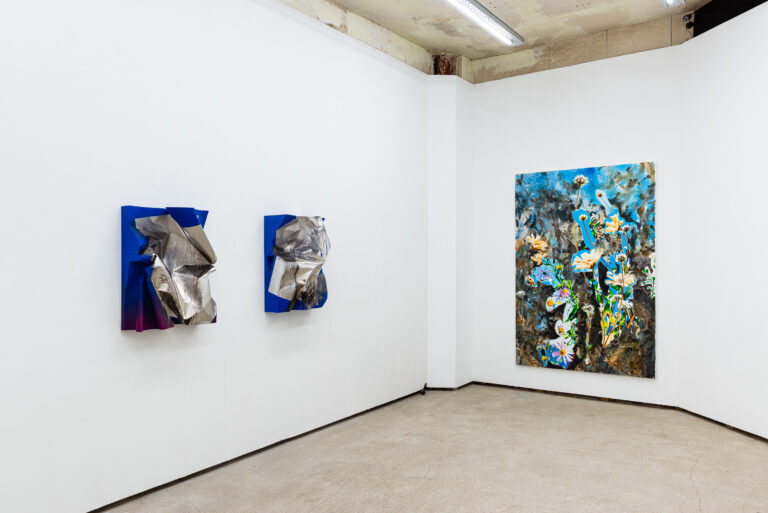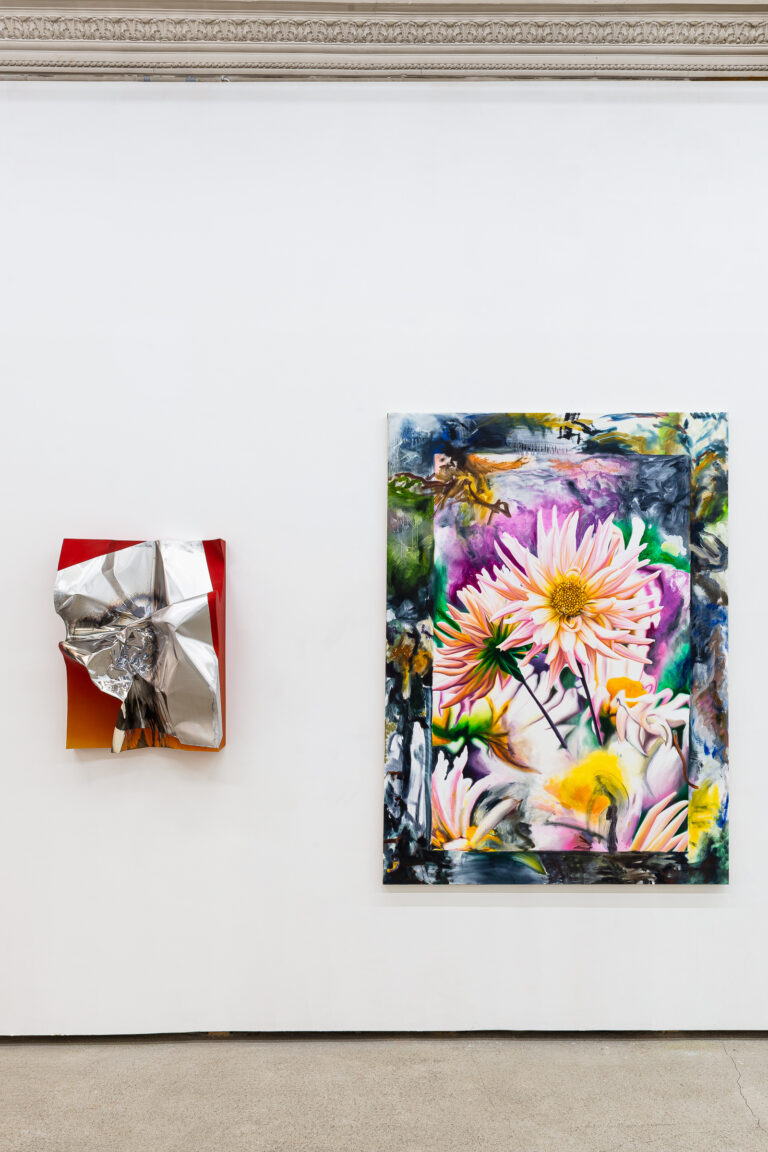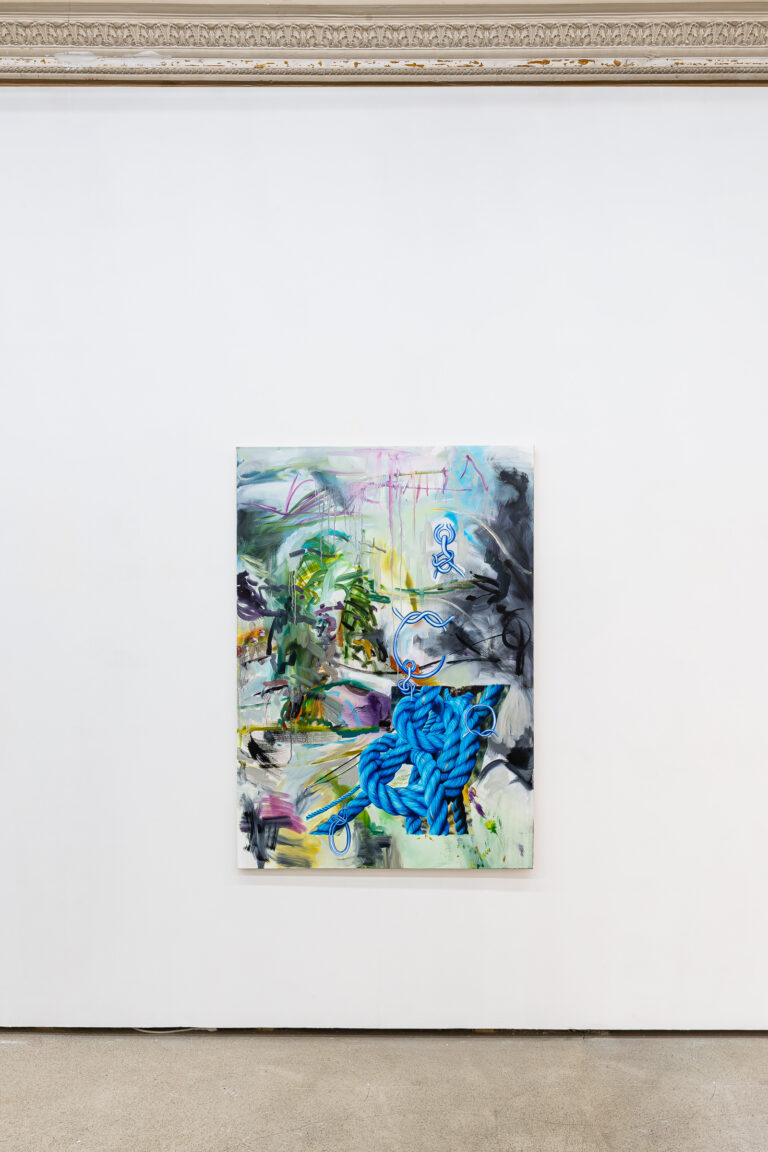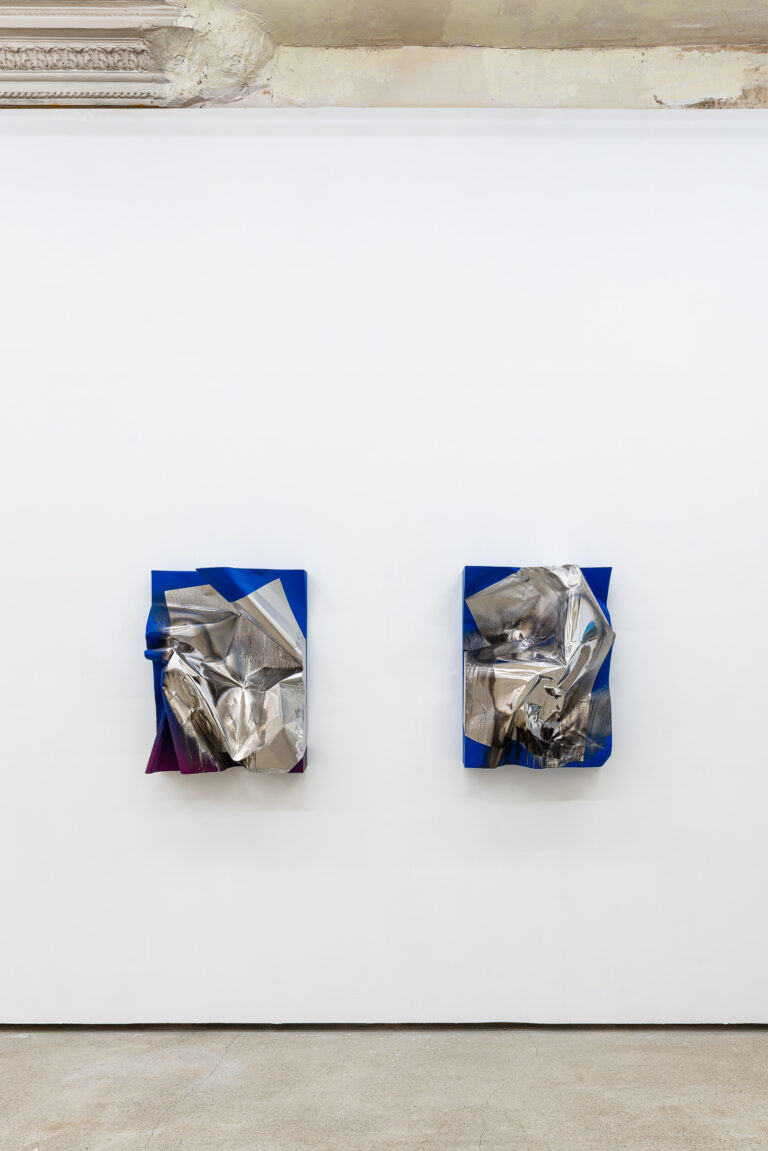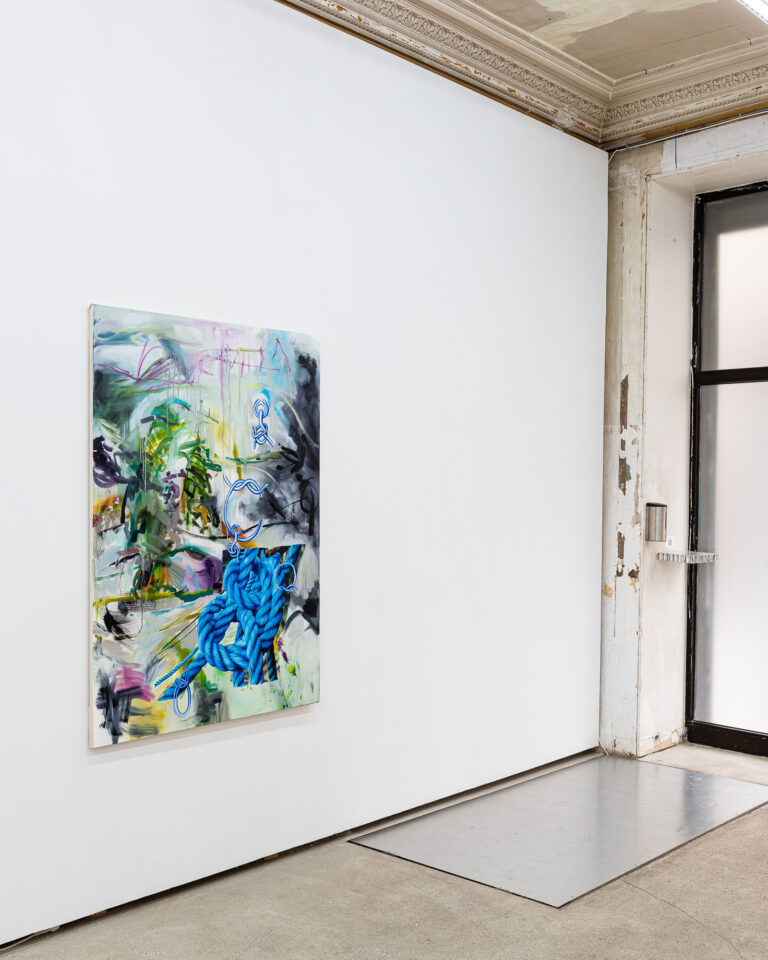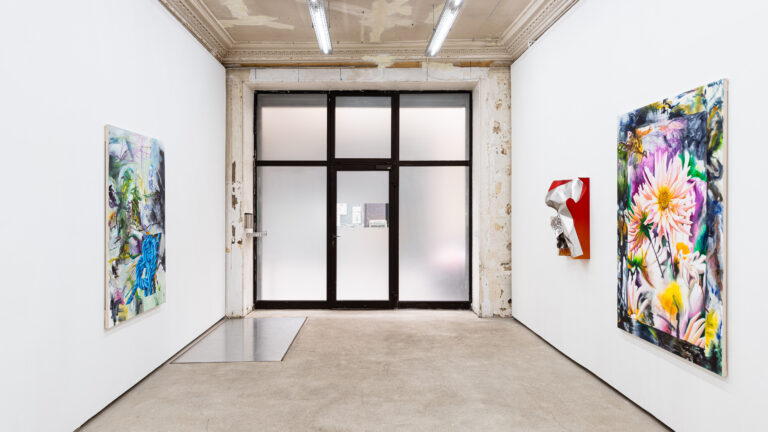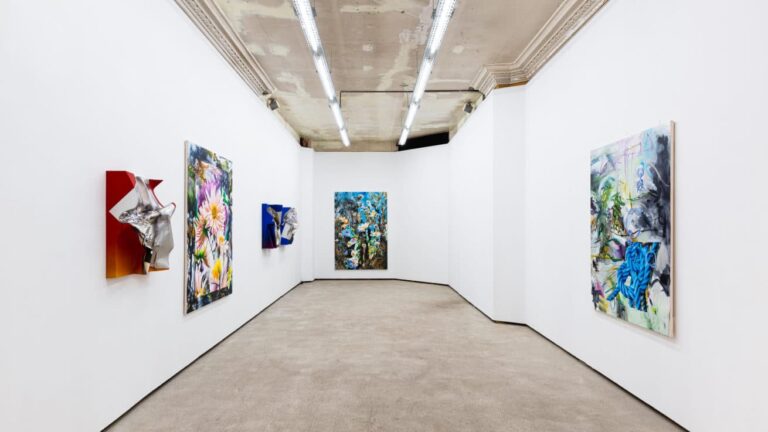Dorian Gaudin, Margaux Valengin
Heedlessly
May 20 - June 19, 2021
Before being conceived as an exhibition, “Heedlessly” was meant to be our booth at Art Brussels 2021. This event being cancelled, we transformed “Heedlessly” into a duo show at the gallery.
Dorian Gaudin (born in 1986) and Margaux Valengin (born in 1992) are two French artists from the same generation who have been living and working in New York for several years. One practices mainly sculpture and installation while the other uses painting. From an aesthetical point of view, nothing could possibly justify a dialogue between these two: Parrino-inspired on one hand and surrealistic on the other hand. But in terms of process, a common methodology of putting oneself into the mental state of creating art makes an interesting connection between both practices. This state of mind – which gave its title to the exhibition – consists in a physical and mental preparation giving relevance to the main theoretical question: “Why does the artist do what he does? And how?”
To this question Dorian Gaudin answers: “I have no rational reason to bend metal sheets, to fight against this material to the point of hurting myself and exhausting myself to create sculptures. There is no rational starting point to explain such a practice. He adds: “It is precisely for this reason that creating requires to free oneself from the “Why? How do we do this?” By abstracting oneself from this state of consciousness we’re in right before starting to create. Our consciousness is tainted by reason and judgment. Yet we must act “Heedlessly”, carefree, to express ourselves freely and to continue doing what we are doing.”
“It’s a form of preparation, a physical and mental conditioning necessary to create.” Gaudin clarifies that this state of meditation is only required for the (very physical) creation of his sculptures, but not for his installations, whose creation is thoughtful and conscious throughout the process: “Even though I don’t know why I make installations either, their creative process is much more rational: I’m in front of my computer, doing calculations and 3D imaging until the object escapes me. So there is also a loss of control, but only when the installation finally takes its autonomy and not before creating it. This mental process is about deep thinking rather than being meditational. When it comes to my sculptures, I have to forget everything before engaging in a battle against the metal sheet.”
Margaux Valengin makes the same observation: “One can indeed speak about a meditative state. For me, this process occurs twice: first when I choose the figurative images to be juxtaposed prior making the figurative composition of my paintings, and then later on when I paint the abstract background. When instinct alone guides our choices, when it inspires the gesture and the color, only then, like an animal, we act without conscious thought, but with real depth. Instinct must take over the reason.”
Hence, “Heedlessly” refers to this state of carefreeness that precedes art, which could also echo “Headlessly” in a wordplay. With her free mind, Valengin is guided by colors while Gaudin keeps being led by his material.
Valengin’s new series tend to evolve more towards abstraction, a pictorial genre that is becoming more and more important to the artist and more prominent in her paintings. An abstract tendency was already apparent in her recent paintings – one thinks for example of the backgrounds of the paintings « Folle » [Crazy] and « Le Chat Aux Trois Yeux » [The Cat with Three Eyes] from 2020, exhibited last September at PACT. In the new series, the abstract part is no longer limited to a few square centimeters of the canvas, it rather even seems to predominate.
To further her creativity towards abstraction, Valengin consciously chose flowers as the figurative starting point for her new paintings. “Flowers are graceful elements which evoke emotion when observed or offered, ditto when painted and when painted around.” Giving free rein to color and abstraction would somehow be facilitated by the emotion generated by the flowers as the starting point of the composition.
Finally to dissociate the figurative from the abstract – a rational movement in the interval between two meditative times – Valengin creates a frame within the canvas, a frame within the frame, which can be seen in the work “Fleurs en Dystopie”. By delimiting the genres -figurative on the one hand, abstract on the other- she blurs the limits of her work by using a trompe-l’oeil. Here is the second common point that links this new series of paintings by Valengin to the new series of wall chromed aluminium sculptures by Gaudin.
Taking as starting point a flat sheet of aluminium, Gaudin gives for the first time a double frame to his sculptures. To begin, the artist bends and distorts the aluminium sheet to the point of creating full edges, curved up to the frame, so we can no longer distinguish the frame at all. When observing these sculptures, one readily imagines them created from a cube of aluminium rather than from a flat surface. Secondly, and for the first time in his relationship with color, Gaudin frames precisely the place on which this artistic accident happened featuring the culmination of his battle with the material (let’s recall here that each sculpture is the result of a performance by the artist fighting against the material to distort it).
Rather than being categorized as framing, this could be portrayed as reframing. Each work then presents a double frame, one for the sculpture itself and one for the painting, both falsely conveying as a trompe-l’oeil.
Showcasing Dorian’s sculptures along the side of these traditional canvas paintings is a way to enrich their meaning, and give purpose to these two formats together in case the viewer was still attempting to answer the main “why?” behind these artistic performances.
Avant d’être conçue comme une exposition, « Heedlessly » (« inconsidérément » ou « avec insouciance » en français) devait prendre la forme d’un stand à la foire Art Brussels. Cette dernière ayant été annulée, le stand s’est mué en un duo show à la galerie, organisé dès l’annonce par le gouvernement d’une réouverture possible.
Dorian Gaudin (né en 1986) et Margaux Valengin (née en 1992) sont deux artistes français de la même génération qui vivent et travaillent à New York depuis plusieurs années. L’un pratique principalement la sculpture et l’installation et l’autre la peinture. Rien dans l’esthétique, Parrinienne d’un côté et surréaliste de l’autre, ne justifie a priori un dialogue entre les deux univers. Rien hormis une méthodologie commune de mise en condition mentale préalable à l’acte de création. Cet état d’esprit -qui a donné son titre à l’exposition- consiste en une préparation physique et mentale à laquelle il nous semble pertinent de s’intéresser puisqu’elle répond en partie à la question théorique : « Pourquoi l’artiste fait-il ce qu’il fait ? Et comment ? »
A cette question Dorian Gaudin répond : « Je n’ai aucune raison rationnelle de tordre des tôles, de me battre contre ce matériau au point de me faire mal et de m’épuiser pour créer des sculptures. Aucun point de départ n’est rationnel pour expliquer pareille pratique.» Il ajoute : « C’est précisément pour cette raison que créer requiert en tant que condition nécessaire, de se libérer du « Pourquoi ? ». Comment ? En sortant de tout état conscient juste avant de commencer à créer. Notre conscience est entachée de raison et de jugement. Or il faut agir « Heedlessly », avec insouciance, pour s’exprimer librement et continuer de faire ce qu’on fait.»
« C’est une forme de préparation, de conditionnement physique et mental nécessaire pour créer.» Gaudin précise que cet état n’est requis que pour la création (très physique) de ses sculptures, mais pas pour ses installations, dont la création est réfléchie et consciente tout au long du processus : « Même si je ne sais pas non plus pourquoi je fais des installations, les concernant le procédé créatif est beaucoup plus rationnel : je suis devant mon ordinateur, je fais des calculs et de l’imagerie 3D -jusqu’a ce que l’objet m’échappe. Il y a donc là aussi une perte de contrôle, mais seulement dans un second temps, lorsque l’installation prend son autonomie. On est davantage dans la réflexion que dans la méditation. Pour les sculptures, je dois tout oublier avant d’engager le combat contre la tôle. »
Margaux Valengin fait le même constat : « On peut en effet parler d’un état méditatif. Me concernant, ce procédé intervient à deux reprises : d’abord quand je choisis les images figuratives à juxtaposer pour réaliser la composition figurative de mes toiles et ensuite quand je peins le fond abstrait. Quand l’instinct seul guide les choix, inspire le geste et la couleur, alors, à la façon d’un animal, on agit hors pensée consciente, avec une réelle profondeur. L’instinct doit prendre le pas sur la raison. »
« Heedlessly » fait donc référence à cet état d’insouciance qui précède l’art et la sonorité du mot n’est pas sans rappeler l’expression « Headlessly », qui pourrait se traduire en français par « fait sans la tête ». L’esprit alors libéré, elle est guidée par la couleur et lui par le matériau.
La nouvelle série de Valengin tend davantage vers l’abstraction, genre pictural qui prend de plus en plus d’importance pour l’artiste et de plus en plus de place dans ses toiles. Une tendance abstraite apparaissait déjà dans ses toiles récentes -on pense par exemple aux fonds des peintures « Folle » et « Le Chat aux Trois Yeux » de 2020, exposées en septembre dernier à la galerie PACT. Dans la nouvelle série, la partie abstraite ne se limite plus à quelques centimètres carrés de la toile, elle semble même prédominer.
Pour favoriser sa créativité dans l’abstraction, Valengin a sciemment choisi les fleurs comme point de départ figuratif de ses nouvelles toiles. « Les fleurs sont des éléments graciles, qui suscitent une émotion quand on les observe ou quand on les offre, idem quand on les peint et quand on peint autour. » Laisser libre cours à la couleur et à l’abstraction serait en quelque sorte facilité par l’émotion générée par les fleurs en tant que point de départ de la composition.
Enfin, comme pour dissocier le figuratif de l’abstrait -relent rationnel dans l’intervalle entre deux temps méditatifs ?- Valengin crée, notamment dans l’oeuvre « Fleurs en Dystopie », un cadre dans la toile, un cadre dans le cadre. En délimitant les genres -figuratif d’une part, abstrait d’autre part, elle brouille les limites de l’oeuvre, à la façon d’un trompe-l’oeil.
Voici là le second point commun qui unit cette nouvelle série de peintures de Valengin à la nouvelle série de sculptures murales en aluminium chromé de Gaudin.
Ce dernier, partant comme à son habitude d’une tôle plane d’aluminium, apporte pour la première fois, à travers cette série, un double cadre à ses sculptures. D’abord, l’artiste plie et déforme ses tôles jusqu’à leur donner des bords pleins, recourbés jusqu’au châssis qu’on ne distingue plus du tout, de sorte qu’en observant ces sculptures, on les imagine volontiers créées à partir d’un cube d’aluminium plutôt qu’à partir d’une surface plane. Ensuite et pour la première fois dans son rapport à la couleur, il encadre précisément l’endroit de l’accident, le point culminant de sa bataille contre le matériau (rappelons ici que chaque sculpture est le fruit d’une performance de l’artiste qui se bat contre le matériau pour le déformer). Plutôt qu’un encadrement, il s’agirait plutôt d’un recadrage. Chaque oeuvre présente alors un double cadre, celui de la sculpture et celui de la peinture, les deux s’inscrivant en faux, comme un trompe-l’oeil. Présenter cette série de sculptures de Dorian Gaudin aux côtés de peintures sur toiles de format traditionnel ajoute à leur lecture, à leur compréhension, et imbriquent le sens des unes aux autres, si tant est qu’on cherche encore à répondre au Pourquoi.

